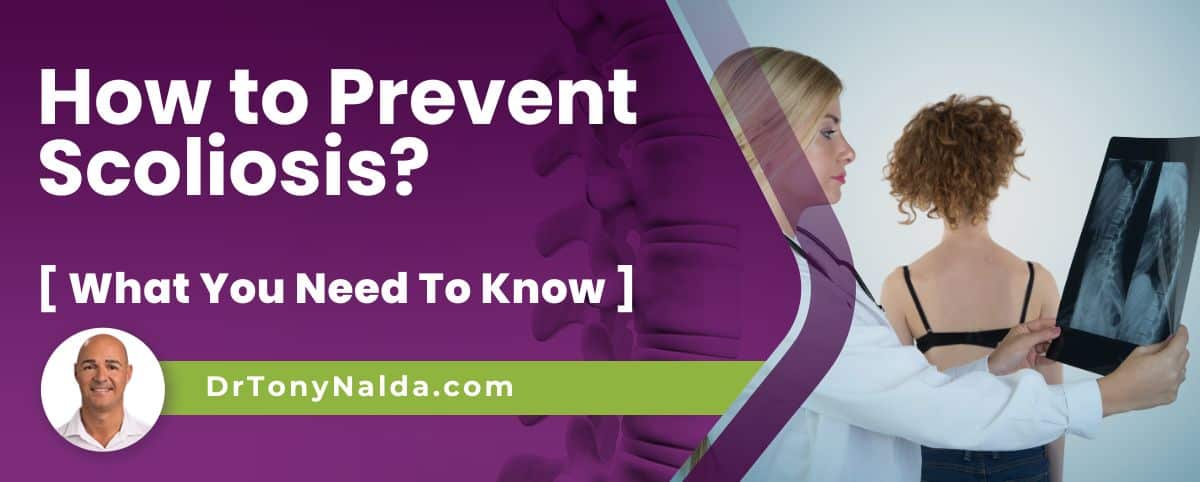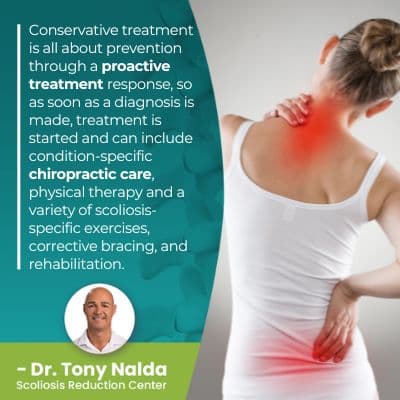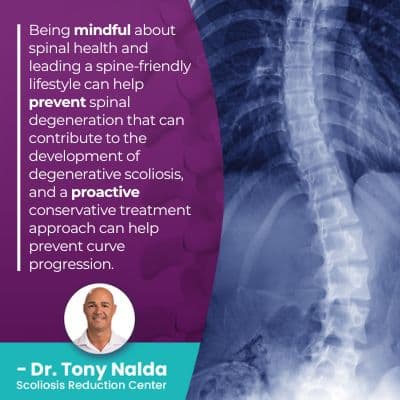How to Prevent Scoliosis? [ What You Need To Know ]

There are different types of scoliosis a person can develop, and in the majority of cases, as we don't know why scoliosis develops, there is no known way to prevent it; degenerative scoliosis, however, is caused by natural age-related spinal degeneration and there are some lifestyle factors that can contribute to its development.
When it comes to the majority of scoliosis cases, we don't fully understand what triggers their onset, so preventative measures are unknown, but we do know that degenerative scoliosis is caused by spinal degeneration, so leading a spine-friendly lifestyle can help manage rates/levels of age-related deterioration.
As a progressive condition, it's important to understand that while most cases of scoliosis can't be prevented, proactive treatment can help prevent conditions from getting worse.
Table of Contents
Most Cases of Scoliosis are Idiopathic
Scoliosis is a highly-prevalent spinal condition that is also progressive, meaning its nature is to get worse over time, so where a scoliosis is at the time of diagnosis isn't indicative of where it will stay.
Scoliosis can range widely in severity from mild to moderate and severe to very severe scoliosis, and there are also different types of scoliosis that people can develop.
The majority of scoliosis cases are classified as idiopathic scoliosis, meaning not clearly associated with a single-known cause, and this accounts for approximately 80 percent of known diagnosed cases, and the remaining 20 percent is associated with known causes: neuromuscular scoliosis, congenital scoliosis, and degenerative scoliosis.
Neuromuscular scoliosis is caused by the presence of a larger neuromuscular condition such as cerebral palsy, muscular dystrophy, and spina bifida, and congenital scoliosis is caused by a malformed spine that develops in utero.
When a condition's cause is unknown, it can be difficult, if not impossible, to prevent its development.
Of the 4 main types of scoliosis, degenerative scoliosis is the one type for which lifestyle factors can be a contributing factor, so we'll return to that condition type later, but for now, I'd like to focus on what can be prevented when treated effectively: progression.
Scoliosis progressing means the size of the unnatural spinal curve is increasing, as are the condition's uneven forces, and their effects.
As scoliosis progresses, the spine gets increasingly rigid, making it less responsive to treatment, and making it difficult for some patients (particularly adults) to perform key therapeutic exercises as part of treatment.
It's far more effective to be proactive with treatment and work towards preventing progression and increasing condition effects than it is to work towards reversing those effects once they're established.
How to Prevent Scoliosis From Getting Worse
 In typical cases of idiopathic scoliosis, their onset can't be prevented, but particularly with early detection and intervention, there are fewer limits to what can be achieved, and the condition can be highly treatable.
In typical cases of idiopathic scoliosis, their onset can't be prevented, but particularly with early detection and intervention, there are fewer limits to what can be achieved, and the condition can be highly treatable.
While we don't know why idiopathic scoliosis develops initially, we do know what triggers its progression: growth.
In the condition's most-prevalent type, adolescent idiopathic scoliosis, diagnosed between the ages of 10 and 18, this age group is the most at risk for rapid-phase progression because of puberty and its rapid and unpredictable growth spurts.
So when rapid progression is a risk, being proactive is especially important, and as scoliosis only gets more complex to treat the more it progresses, watching and waiting to merely observe conditions is wasting valuable treatment time.
Conservative treatment is all about prevention through a proactive treatment response, so as soon as a diagnosis is made, treatment is started and can include condition-specific chiropractic care, physical therapy and a variety of scoliosis-specific exercises, corrective bracing, and rehabilitation.
While there are never treatment guarantees, with early detection and intervention, there are fewer limits to what can be achieved, and that means preventing progression, increasing condition severity, and the effects.
So now that we've talked generally about what can and can't be prevented with scoliosis, let's talk specifically about how leading a spine-friendly lifestyle can affect the development of degenerative scoliosis.
How to Prevent Degenerative Scoliosis
Idiopathic scoliosis cases are considered typical, and cases with known causes are considered atypical.
When it comes to degenerative scoliosis, after idiopathic scoliosis, degenerative scoliosis is the second most common type to be diagnosed in adults.
As mentioned, the main cause is natural age-related spinal degeneration, and while there is a certain amount of natural spinal degeneration to be expected with age, a person's spinal health and lifestyle will shape the rate and level of those degenerative changes.
Spinal degeneration most often starts with the intervertebral discs that sit between adjacent vertebrae; these discs give the spine structure (adjacent vertebrae attach to the disc in between), flexibility, act as the spine's shock absorbers, and provide cushioning between adjacent vertebrae to prevent friction during movement.
Once a disc starts to degenerate, it changes shape, and this affects the position of attached vertebrae, disrupting the spine's ability to maintain its natural curves and alignment.
Lifestyle choices that can impact the health of the spine and its individual structures include carrying excess weight, leading a sedentary lifestyle, chronic poor posture, excessive consumption of alcohol and/or smoking, and repeatedly lifting heavy objects incorrectly.
 Carrying excess weight means more pressure on the body's joints, including the spine, and this means compressing the discs more than in a person who is maintaining a healthy weight.
Carrying excess weight means more pressure on the body's joints, including the spine, and this means compressing the discs more than in a person who is maintaining a healthy weight.
Leading a sedentary lifestyle is contrary to the spine's movement-based design, and of course, it can also lead to carrying excess weight.
The discs are the largest structures inside the body without their own vascular supply, which means there is no direct path into and out of the discs through which important nutrients needed for repair can flow and waste can be eliminated; exercise and movement protects the health of the spinal discs by increasing circulation, which increases the blood flow around the discs, making the nutrients more readily available through a process similar to osmosis and keeping the discs as hydrated as possible.
Good posture is important because over time, chronic poor posture introduces adverse spinal tension and compression to the spine, and this can contribute to early degenerative changes.
Excessive consumption of alcohol and/or smoking also contributes to disc desiccation and the development of degenerative disc disease, which is a contributing factor in the development of a number of spinal conditions/issues.
Particularly for those whose occupations involve repeatedly lifting heavy objects, not understanding the ergonomics of heavy lifting can, over time, contribute to premature spinal degeneration and makes the spine more vulnerable to injury.
Scoliosis patients who have been diagnosed with degenerative scoliosis can choose between surgical treatment or nonsurgical treatment options.
Being mindful about spinal health and leading a spine-friendly lifestyle can help prevent spinal degeneration that can contribute to the development of degenerative scoliosis, and a proactive conservative treatment approach can help prevent curve progression.
Conclusion
While in the majority of cases, scoliosis prevention isn't possible, maintaining a healthy spine through a healthy lifestyle means scoliosis treatment is more likely to be successful.
As a largely idiopathic condition, we don't fully understand if it's even possible to prevent scoliosis because we don't fully understand what triggers its initial development, but we know a growth spurt is what triggers progression.
So when it comes to preventing scoliosis progression, scoliosis that's diagnosed early can be highly treatable, and knowing the early signs of scoliosis can help spot scoliosis before significant progression has already occurred: one shoulder being higher than the other (uneven shoulders), uneven hips, the development of a rib cage arch, and arms and legs that appear to hang at different lengths.
Awareness of the condition's symptoms can lead to early detection, proactively preventing curvature progression, pain relief, and avoiding the need for invasive spinal fusion surgical treatment in the future.
As I believe that a conservative treatment plan preserves as much of the spine's natural strength and function as possible, I feel that patients who experience conservative treatment success have the best possible quality of life.
So what I really want patients, and their families, to understand is that most types of scoliosis can't be prevented, but when it comes to a scoliosis diagnosis, the more relevant issue is how to respond with treatment.
Developing degenerative scoliosis can be affected by lifestyle factors, so of the four main types of scoliosis, this is the form that is the most preventable through leading a spine-friendly lifestyle that involves maintaining a healthy weight, activity level, good posture, and lifting heavy objects with the legs rather than the back.
Here at the Scoliosis Reduction Center, I treat scoliosis proactively so as much of the condition's effects as possible are minimized.
Dr. Tony Nalda
DOCTOR OF CHIROPRACTIC
After receiving an undergraduate degree in psychology and his Doctorate of Chiropractic from Life University, Dr. Nalda settled in Celebration, Florida and proceeded to build one of Central Florida’s most successful chiropractic clinics.
His experience with patients suffering from scoliosis, and the confusion and frustration they faced, led him to seek a specialty in scoliosis care. In 2006 he completed his Intensive Care Certification from CLEAR Institute, a leading scoliosis educational and certification center.
About Dr. Tony Nalda
 Ready to explore scoliosis treatment? Contact Us Now
Ready to explore scoliosis treatment? Contact Us Now





